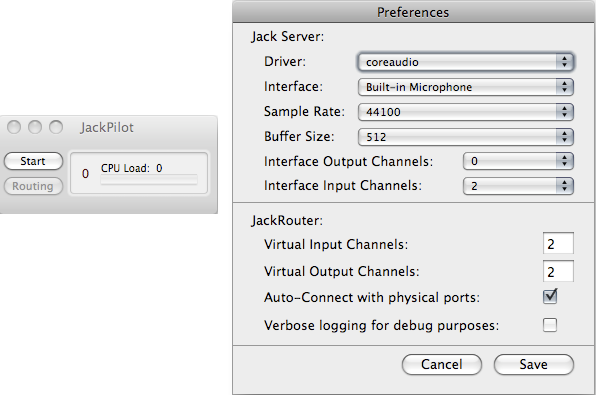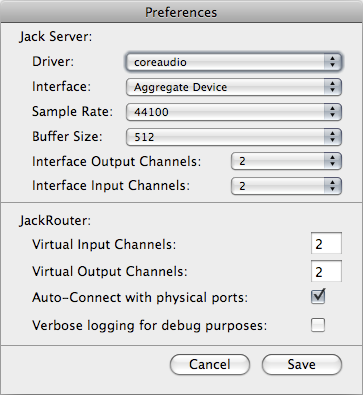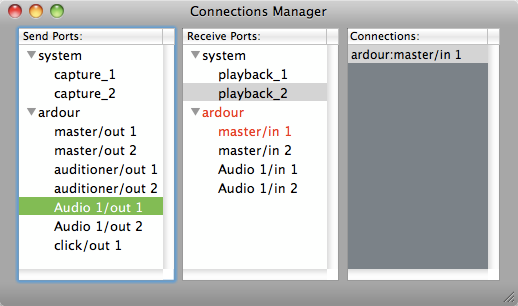Starting Jack on OS X
Now that you have Jack installed on your Mac, start it simply by double-clicking on the JackPilot icon in your Applications folder:
![]()
You should see two windows: JackPilot and Preferences. If you don't see either of the windows, you can open them via the menus: Window > JackPilot (for JackPilot) and JackPilot > Preferences (for Preferences). This is how these windows look:

The Preferences window allows you to configure important settings, such as Driver, Interface, Sample Rate, Buffer Size, Input Channels and Output Channels. See below for more information on each of these settings.
Note that the Preferences window has two sections: the Jack Server and the Jack Router. The Jack Server is the actual "engine" of the JACK Audio Connection Kit. Jack Router takes care of the connections between different applications.
Any changes you make to the default settings will take effect after you click on Save.
The JackPilot window is simply a separate user interface that makes it possible to control both the engine (Jack Server) and the routing (Jack Router). You can start the Jack Server by clicking on Start, and you can manage connections between applications by clicking on Routing. Once JACK is running, JackPilot should look like this:

Later on, when you want to quit JACK, the correct procedure is first to click on the Stop button on JackPilot and then to close JackPilot itself (cmd + Q). It is important to note that if you quit JackPilot without having clicked on the Stop button beforehand, you will be closing the user interface called JackPilot, but NOT the Jack Server itself (the "engine"), which in this case will still be running in the background.
Note that the difference between JackPilot and the JACK engine is made explicit in the wording of the Quit option via the menu: you click on JackPilot > Quit JackPilot (Not JACK)
Understanding the Preferences Window
The following section presents a brief explanation of each of the options in the Preferences window. The information below is adapted from the JackPilot Documentation. You can find the complete documentation inside your Jack folder (Applications > Jack > Documentation.pdf).
Driver – the physical audio driver. Choose 'coreaudio', the only option currently available.
Interface – select the physical audio device that you would like the Jack server to communicate with (for example, a FireWire or USB interface or the built-in audio of your computer). Currently, Jack can only communicate with one hardware audio device at a time. This means that if you have a newer Mac computer (2007 and later) and you want to use your built-in audio input and output, you still have a one-time configuration step to do: create an Aggregate Device, using Audio MIDI Setup. See detailed information on the section Audio MIDI Setup on OS X. Once this is done, you should be able to choose your newly created Aggregate Device on JackPilot's Preferences window. This will allow you to use JACK and Ardour with your computer's built-in input and output.

Sample Rate – choose your desired sample rate for the Jack server. Only sample rates supported by the selected Interface will be displayed. If in doubt, leave the default.
Buffer Size – choose your desired audio buffer size (in samples). Only buffer sizes supported by the selected Interface will be displayed. If in doubt, leave the default.
Interface Output/Input Channels – choose your desired number of Output and Input audio channels for Jack to communicate with your physical audio interface. The maximum number of channels is limited by the number of output and input channels supported by your physical audio device.
Virtual Input Channels – the number of virtual input channels Jack will provide for each application. Typically this should be set to 2, for stereo operation.
Virtual Output Channels – the number of virtual output channels Jack will provide for each application.
Auto-Connect with physical ports – check to allow JackPilot to automatically connect the Virtual Input and Output Channels to your physical audio device input and output ports, respectively.
Verbose logging for debug purposes – check to allow Jack OS X to write more complete log messages to the Console, which is useful for debugging in problem cases.
Once you have chosen your settings, click on Save to exit the Preferences window.
Note that the Preferences can only be changed when the JACK server is stopped, not when it is running.
Routing with JackPilot
This section will help familiarize you with JackPilot's routing interface.
With the Jack server on, click on the Routing button in JackPilot to bring up the Connections Manager window. The following is an example of what you might see if you had not yet Jack-enabled any applications. All you see is the physical audio device (generically called “system”) and its send (“capture”) and receive (“playback”) ports.

As you open other Jack-enabled audio applications, their inputs and outputs will show up in the Connections Manager. For example, when you have Ardour open, you will see something like this:

Any sound source listed on the left may be connected to any of the receive ports listed on the right. Multiple Send Ports can be routed to one Receive Port and, conversely, one Send Port can be routed to multiple Receive Ports.
Here's an example of some routings that are internal to Ardour:

The ardour:Audio 1 track outputs are routed to the ardour:master inputs. This is the default routing for all new Audio tracks created in Ardour, and it allows the master bus to 'collect' the audio signals from all tracks together.
Managing Ardour connections may be done in this window, or this may be done entirely from within Ardour. The result is the same. If you will be working only with Ardour, you probably won't need to come back to JackPilot Connections Manager at all. However, as you start doing more complex connections between different audio applications, you may need to use JackPilot Connections Manager. For more information, please refer to the JackPilot Documentation.





